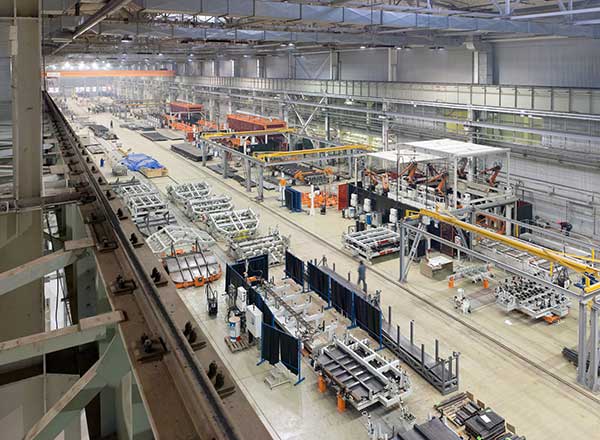Manufacturers are under pressure to do more with less. Here’s how you can protect your facilities while making every security dollar count.
By Jason Porter
An era of economic headwinds, global instability, and industry-specific disruptions has pressured many manufacturers to trim budgets wherever possible. As it’s not always easy to quantify its value, security often ends up on the table during these discussions.
But trimming security without a strategic plan is dangerous. History shows companies that slash protections often end up spending far more later to recover from incidents or disruptions.
The smartest manufacturers are finding ways to make their security programs leaner without making them weaker. And it starts by understanding how all the parts of your security infrastructure fit together.

Security in manufacturing environments isn’t a single line item, but an ecosystem. This might include physical guard forces, surveillance technology, access controls, cybersecurity measures, employee training, incident response plans, and so on. Often, these components are interdependent. Removing or weakening one element of a program may create a cascade of security vulnerabilities.
Before making any changes, take a step back and break your security operations into manageable categories—ideally five to seven core functions—and look at how each supports the rest. The goal here is to find opportunities to streamline without undercutting core protections.
Manufacturing often demands security roles that serve multiple purposes, such as protecting assets, ensuring workplace safety, and maintaining compliance. That complexity means what looked like one expense is actually a linchpin holding several risk controls together. Identify those linchpins before making any budgetary decisions.
Once your system is mapped, you can begin identifying where efficiencies exist. But not every case of overlap is waste. In security, some redundancy is intentional and vital. The question is whether two systems are providing backup or just duplicating effort.
Create three simple categories for every element of your program:
The goal is to reduce spend without weakening your baseline defenses. A redundant sensor or unused subscription may be easy to cut, but removing an overlapping patrol route that serves as a visible deterrent and response point deserves more scrutiny.
The process mirrors lean manufacturing audits: reduce waste, retain function. And like any good audit, it should involve input from multiple stakeholders spanning operations, facilities, IT, and safety, to validate you don’t miss a key piece of the puzzle.
Security should always be tied to risk. As the business evolves, many programs fail to update their priorities. That can lead to overprotection in some areas and blind spots in others.
Take a hard look at what you’re protecting and why. Has a facility wing been decommissioned? Are you using more automation? Have new materials or processes introduced different risks?
Then, rank your assets by criticality and threat likelihood. Security spending should match those priorities, not outdated ones. If a previously high-value storage area now handles bulk, low-risk goods, a rigorous security presence might be excessive. On the other hand, a new proprietary process or automated line could justify enhanced surveillance or stricter access protocols.
This exercise also helps avoid legal and reputational risks. Inadequate security lawsuits often hinge on whether a company met the “standard of care” for its industry. Plaintiffs will ask, “Did you cut corners in a way that a reasonable manufacturer wouldn’t?”
Any reductions must be backed by a clear, documented rationale.
When you’re immersed in operations, it’s easy to overlook what’s hidden in plain sight. That’s why many manufacturers bring in third-party experts or consultants when evaluating their security programs.
An outside perspective can reveal not only gaps, but also dangerous assumptions. For example, one manufacturing facility had a longstanding practice of storing explosive materials right next to its fuel depot. It had always been done that way, and staff were desensitized to the danger. When an outside consultant walked the site, the alarm bells rang immediately that this was a catastrophe waiting to happen. In scenarios like that, one mistake could literally be explosive.
Bringing in an outsider also creates a record of due diligence. If your cost-cutting decisions are ever questioned by leadership, regulators, or legal teams, having a vetted plan backed by an external expert shows that changes were strategic, not reckless.
Some security capabilities are simply more efficient when handled by specialists. For instance, running a 24/7 security operations center (SOC) with a team of analysts and the latest threat detection technology is immensely costly. But there are firms offering SOC-as-a-service or subscription-based monitoring that spread those costs across many clients, delivering you high-quality coverage for a fraction of what it would cost to staff and equip your own.
By leveraging a vendor’s scale and expertise, you transform fixed costs into variable costs and pay only for what you need. This can apply to functions like alarm monitoring, cyber threat intelligence, employee background vetting, emergency response planning, and more. If your risk profile changes or a new threat emerges, a large security partner can often pivot quickly and scale up or adjust services, whereas an internal department might be stuck with sunk costs or outdated tools.
You should, of course, be careful not to outsource your entire security program. Certain core functions like leadership oversight, emergency decision making, and company-specific policy enforcement should remain in-house. But a hybrid model can significantly reduce overhead, and the intangible costs saved—such as avoiding lengthy hiring processes, training, and the risk of a bad hire—also add up.
Cost pressures are unlikely to ease in the near term. Manufacturers will continue to face global competition, labor shortages, and geopolitical uncertainty. That makes resilience—not just compliance—the true goal of a well-designed security program.
The most effective security leaders think like engineers. They understand the mechanics of risk and build systems that can withstand strain. That doesn’t mean spending more, just smarter.
A resilient security program has:
When done right, security becomes a strategic asset, not just a cost center. It prevents losses, accelerates recovery, and protects the brand.
Cutting costs doesn’t need to invite risk. With the right structure, the right mindset, and the right tools, manufacturers can reduce spend while keeping people, property, and operations secure.
Because at the end of the day, the cost of a preventable incident will always exceed the cost of a well-run program.

About the Author:
Jason Porter, CPP, is a vice president at Pinkerton and is an expert in corporate, criminal and civil investigations and executive protection. Jason has over 15 years of high-level corporate security experience and has earned a Certified Protection Professional (CPP) certification from the American Society for Industrial Security (ASIS).
In this episode, I sat down with Beejan Giga, Director | Partner and Caleb Emerson, Senior Results Manager at Carpedia International. We discussed the insights behind their recent Industry Today article, “Thinking Three Moves Ahead” and together we explored how manufacturers can plan more strategically, align with their suppliers, and build the operational discipline needed to support intentional, sustainable growth. It was a conversation packed with practical perspectives on navigating a fast-changing industry landscape.